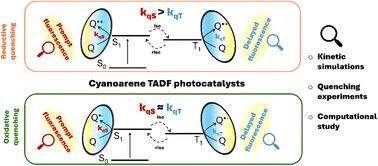显示热激活延迟荧光(TADF)的有机光催化剂的反应性:最低单线态和三重态猝灭率之间意想不到的差异的合理化
IF 7.4
1区 化学
Q1 CHEMISTRY, MULTIDISCIPLINARY
引用次数: 0
摘要
氰芳烃发色团表现出热激活延迟荧光(TADF),越来越多地用于光氧化还原催化。在高浓度的有机底物(通常用于制备合成)中,光催化过程中的初级光诱导电子转移(PeT)步骤可以涉及TADF发色团的单线态(S1)和三重态(T1)激发态,尽管前者的寿命非常短(纳秒)。然而,这些状态的反应性之间的差异尚不清楚,而对光催化过程至关重要。在这项工作中,研究了三个具有代表性的TADF发色团在还原和氧化PeT猝灭反应中的作用。首先,通过动力学模拟,我们认为基于实验测量的提示和延迟荧光寿命而不是积分强度的Stern-Volmer猝灭图可以为涉及S1和T1激发态的PeT猝灭反应提供准确的双分子速率常数。其次,对提示和延迟荧光的实验测量表明,S1的还原猝灭速率常数明显高于T1,而氧化猝灭速率常数几乎相等。电子结构计算揭示了PeT还原猝灭速率的差异,表明这可能源于S1和T1态空穴电子空间分布的不同。综上所述,我们的发现为涉及TADF发色团的光催化过程提供了重要信息,这将有助于设计下一代TADF光催化剂。本文章由计算机程序翻译,如有差异,请以英文原文为准。

Reactivity of organic photocatalysts displaying thermally activated delayed fluorescence (TADF): rationalizing unexpected differences between rates of quenching of the lowest singlet and triplet states
Cyanoarene chromophores exhibiting thermally activated delayed fluorescence (TADF) are increasingly used in photoredox catalysis. At high concentrations of organic substrates, which are typically employed in preparative synthesis, the primary photoinduced electron transfer (PeT) steps in the photocatalytic processes can involve both singlet (S1) and triplet (T1) excited states of TADF chromophores, despite very short lifetimes (nanoseconds) of the former. However, the difference between the reactivities of these states is not well understood, while being critically important for the photocatalytic process. In this work, three representative TADF chromophores were examined in reductive and oxidative PeT quenching reactions. First, using kinetic simulations, we assert that Stern–Volmer quenching plots based on the experimentally measured prompt and delayed fluorescence lifetimes, but not integrated intensities, yield accurate bimolecular rate constants for the PeT quenching reactions involving S1 and T1 excited states. Secondly, experimental measurements of prompt and delayed fluorescence reveal significantly higher quenching constants for reductive quenching of S1 compared to T1 states, while for oxidative quenching the rate constants are nearly equal. Electronic structure calculations provide insight into the difference between the PeT rates for reductive quenching, suggesting that it might stem from the different spatial hole–electron distributions in S1 and T1 states. Taken together, our findings bring crucial information about the photocatalytic process involving TADF chromophores that should aid the design of the next-generation of TADF photocatalysts.
求助全文
通过发布文献求助,成功后即可免费获取论文全文。
去求助
来源期刊

Chemical Science
CHEMISTRY, MULTIDISCIPLINARY-
CiteScore
14.40
自引率
4.80%
发文量
1352
审稿时长
2.1 months
期刊介绍:
Chemical Science is a journal that encompasses various disciplines within the chemical sciences. Its scope includes publishing ground-breaking research with significant implications for its respective field, as well as appealing to a wider audience in related areas. To be considered for publication, articles must showcase innovative and original advances in their field of study and be presented in a manner that is understandable to scientists from diverse backgrounds. However, the journal generally does not publish highly specialized research.
 求助内容:
求助内容: 应助结果提醒方式:
应助结果提醒方式:


